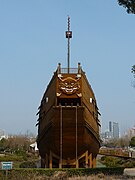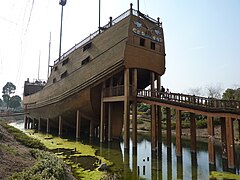Treasure ship
Treasure ships ( Chinese 寶船 / 宝船 , Pinyin bǎochuán ) are among the largest sailing ships ever built and were built in China in the early 15th century under the rule of Emperor Yongle . These ships were between 59 and 84 meters long and supposedly carried up to 9 masts.
Chinese ocean-going ships
Chinese ocean shipping was characterized by junks . In addition to these flat-bottomed ships, there were also other large, ocean-going ships that shared many design features with junks during the Song Dynasty (960–1279 AD). In contrast to the junks, these ships had a V-shaped hull and a keel . In 1973, the wreck of one such ship was found in Quanzhou , which probably sank around 1270. Two layers of cedar planking in Kraweel construction extend over the 13 compartments along the almost 33 m long keel, making it a size comparable to European ships of the time. In the hold of the wreck there were still spices and scented woods that are said to have come from East Africa. Research suggests that the Song-era Chinese tried to imitate a foreign shipbuilding tradition here . Apparently these attempts remained, because this technique can no longer be proven after 1270, so it was not adopted for Chinese shipbuilding. Whether this construction had any influence on the construction of the treasure ships is completely unknown and can no longer be reconstructed.
The only archaeological find so far that actually indicates the existence of the large treasure ships was excavated in the ruins of the Dragon River Shipyard (near Nanjing ) in 1957. It is an 11 m long stern post made of pine wood, to which the rudder blade of the ship was attached. At first this was thought to be evidence of the extraordinary size of the treasure ships. Since then, however, Chinese shipping historians have objected that, based on the Ming-era ships, this stern post could only belong to ships with a total length of about 45 m.
Construction
With regard to the construction, the sources are thin. Descriptions of the ships appear in the travelogues of the Chinese translator Ma Huan about the voyages of Admiral Zheng He . The ships are also mentioned in texts about the Ming emperor Yongle (1402–1424). Images, e.g. B. on wood prints, are only preserved from later centuries.
Treasure ships are said to have been 100 to 138.4 m long, but according to current research, scientists assume a length between 59 and 84 m. The author Guan Jingcheng drew attention to the unrealistic numbers as early as 1947 and estimated the treasure ships to be 62 m in length. Joseph Needham, however, was of the opinion that the figures may have been misunderstood and suggests 84 m. Xin Yuanou estimates the total length at 59 m, which is largely accepted by research.
With its raised superstructures at the bow and stern, the surface structure was reminiscent of the appearance of oversized junks. The bow consisted of a square mirror , decorated with painted eyes, which merged into the flat hull below the surface of the water.
Unlike contemporary European ships, treasure ships (junk style) had about a dozen watertight compartments. These transverse bulkheads took up the entire height of the hull and had no hatches, so that each compartment was only accessible from above. This construction made the hull very stable and safe. The weight of such a ship is estimated between 500 and 1,000 t .
According to Chinese tradition, the rigging consisted of masts with lug sails made of red silk, which were reinforced with bamboo. The up to nine masts were not in a row, but partly next to each other or offset diagonally. However, the traditional number of masts is also viewed critically by many researchers, now it is more likely that three to four masts are assumed ( see picture above ). The ships were armed with 24 bronze cannons in order to be able to defend themselves against pirates and rebel princes.
It is questionable to what extent the treasure ships were really efficient sailing ships. Their size (also at 59 m) primarily served to impress foreign peoples and was not designed to ensure rapid progress. Due to their size, the treasure ships were slow and difficult to steer, which was particularly detrimental in storms. They were also extremely costly to maintain.
Preserved stern post (Drachenfluss shipyard)
The expeditions of Zheng He
The treasure ships became known through the seven voyages of Admiral Zheng He from 1405 to 1433, which, among other things, verifiably led to Africa and various coasts of the Indian Ocean .
The end of the treasure ships
The end of the state ocean-going fleet came in 1435 with the death of Emperor Xuande . The subsequent emperors turned to the serious internal problems of the empire (Mongol invasions and natural disasters) and saw no concrete equivalent to the immense costs devoured by the fleet. In the ongoing fight against the Wokou (Japanese pirates), Emperor Hongzhi declared the construction of ships with more than two masts to be a crime in 1500, and in 1525 Emperor Jiajing even ordered the destruction of all ocean-going ships, which was largely not followed. Emperor Longqing lifted all edicts of restrictions in 1567 due to poor implementation and the negative consequences for Chinese trade relations. But the state ocean-going fleet was not revived, nor were junks ever built again, which, like the treasure ships, were longer than 50 m. One of the reasons for this is likely to have been the technical problems that sea-worthy junks of this length have.
Comparison with Europe
If one takes the dimensions of 59 to 84 m in length favored by research as a basis, it can be determined that the simultaneous European shipbuilding was able to achieve similar dimensions. The flagship Grace Dieu of King Henry V of England, completed in 1418, and his sister ships were 67 m long, comparable to the Chinese treasure ships.
See also
Web links
- Ulrich Baron: The ships of the dragon , in: Die Zeit 8/2005, February 17, 2005
Individual evidence
- ↑ a b c d e Sally K. Church: The Colossal Ships of Zheng He - Image or Reality? in: Claudine Salmon (Ed.): Zheng He - Images & Perceptions. South China and Maritime Asia. Vol. 15. Ed. Roderich Ptak, Thomas Höllmann. O. Harrasowitz, Wiesbaden 15.2005, pp. 155-176. ISBN 3-447-05114-0 ISSN 0945-9286
- ↑ Historical source, Ming Dynasty History ( Ming shi ), written 1644–1735, published 1739.
- ↑ Xin Yuanou: Guanyu Zheng He baochuan chidu de jishu fenxi (A Technical Analysis of the Size of Zheng He's Ships). Shanghai 2002, p. 8. (Professor of marine engineering at Shanghai Jiaotong University)





